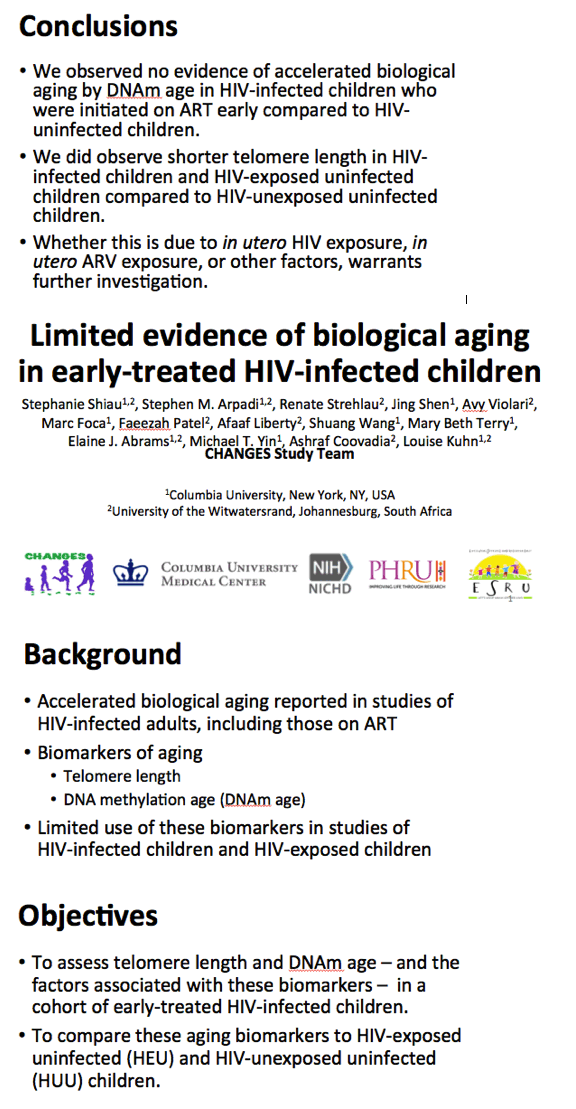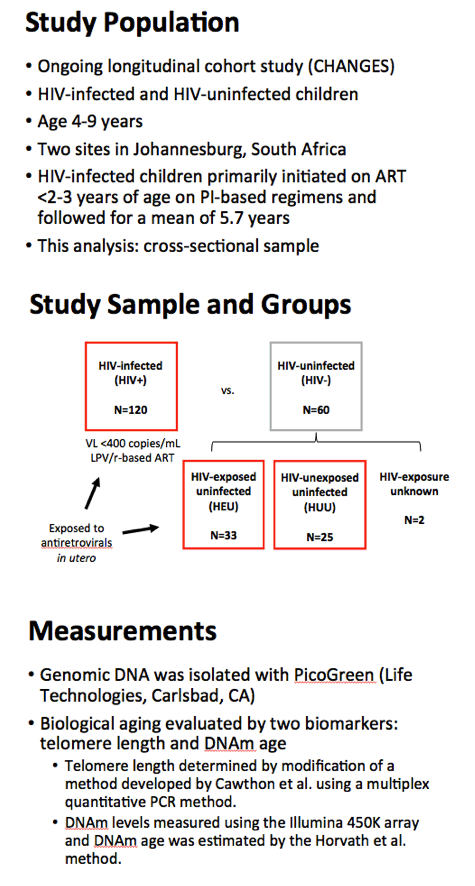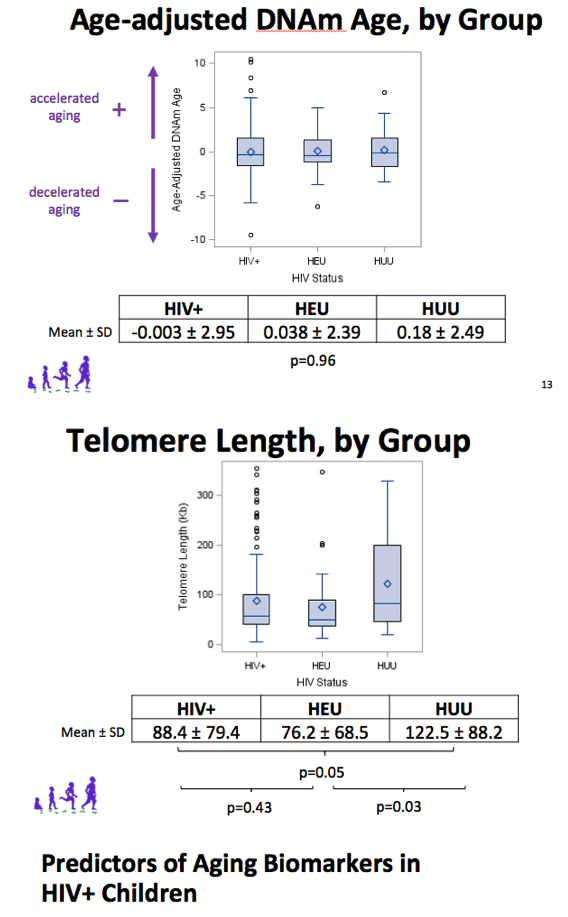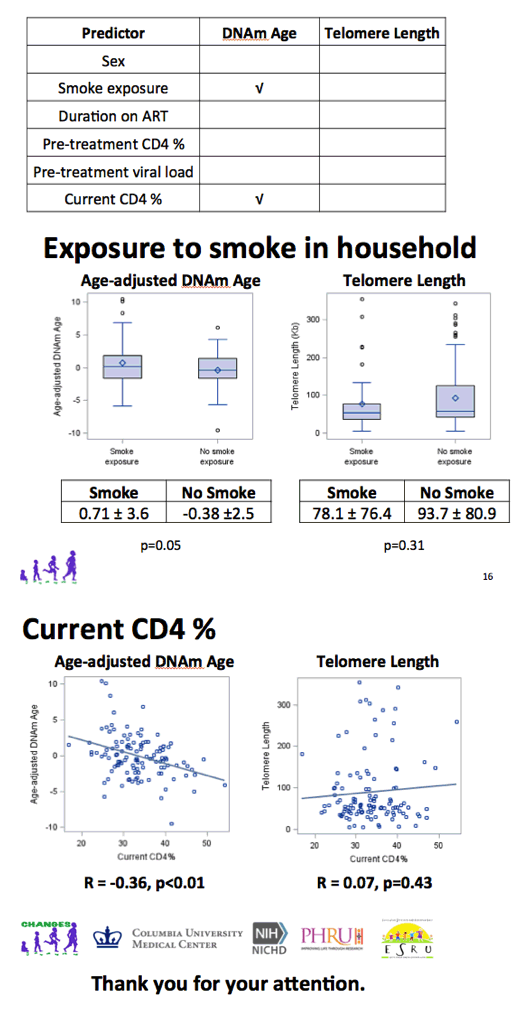 |
 |
 |
| |
Limited evidence of biological aging in early-treated HIV-infected children
|
| |
| |
from Jules: I asked in the Q&A if this finding of no evidence of accelerated aging by DNAm in children, which is not what they found with adult, could be do to short followup & might change with longer followup and presenter said yes longer followup may find an association. This was presented at Workshop the day before:
Antiretroviral Therapy Does Not Dial Back Advanced Epigenetic Age With HIV - (09/27/16)
Equivalent "Biological Age" in Children on Early ART and HIV-Negative Group
8th International Workshop on HIV and Aging, October 2-3, 2017, New York
Mark Mascolini
Biological (versus chronological) age estimated by DNA methylation proved similar in HIV-positive children who began antiretroviral therapy (ART) before the age of 2 or 3 years and in HIV-negative children in Johannesburg [1]. But telomere length proved shorter in HIV-infected children and HIV-exposed uninfected (HEU) children than in HIV-unexposed uninfected (HUU) children. And the study linked cigarette smoke exposure to older DNA methylation age in children with HIV.
An epigenetic clock that measures DNA methylation to gauge biological age indicates older DNA methylation age than chronological age in adults with untreated HIV infection [2], an effect not reversed by starting ART [3]. Other research uses telomere length as a biological aging marker in adults with HIV [4]. But little work has attempted to gauge biological age via DNA methylation or telomere length in children with HIV infection. Collaborators at Columbia University in New York City and the University of Witwatersrand in Johannesburg set out to do that in three groups of 4- to 9-year-old children with or without HIV infection.
The analysis involved 120 HIV-infected children, 53% of them girls, and 60 HIV-uninfected children, half of them girls, all making their enrollment visit in the Johannesburg CHANGES cohort study. Age averaged 6.4 years in the HIV group, 6.1 in HEU children, and 6.9 in HUU children. Children with HIV began ART before 2 or 3 years of age and attained a viral load below 400 copies with a lopinavir/ritonavir regimen. The HIV-uninfected group included 33 HEU children, 25 HUU children, and 2 children with unestablished HIV exposure status.
The researchers used a multiplex quantitative PCR method to measure telomere length. They estimated epigenetic age with the DNA methylation method of Horvath [5]. The research team assessed epigenetic age as "age-adjusted DNA methylation age," in which a positive value indicates accelerated aging compared with chronological age. In HIV-infected children, they assessed the impact of five predictors on epigenetic age: sex, household exposure to cigarette smoke, time on ART, pretreatment CD4 percentage and viral load, and current CD4 percentage.
DNA methylation age correlated positively with chronological age (r = 0.57, P < 0.01) but telomere length did not (r = -0.01, P = 0.9). The researchers noted that the flat telomere length slope in these children may reflect the previously described plateau in telomere shortening around this age [6,7]. The positive correlation between DNA methylation age and chronological age did not differ much between the three groups of children: HIV, HEU, HUU.
Age-adjusted DNA methylation age proved similar in children with and without HIV (-0.003 +/- 2.95 and 0.006 +/- 2.45, P = 0.99), a finding indicating that HIV-positive children who begin suppressive ART before age 2 or 3 years have a biological age similar to HIV-uninfected children in South Africa. Neither did age-adjusted DNA methylation age differ between the HEU group and the HUU group (0.038 +/- 2.39 and 0.18 +/- 2.49, P = 0.824).
Average telomere length proved significantly shorter in children HIV than in HUU children (88.4 +/- 79.4 versus 122.5 +/- 88.2, P = 0.05). HEU children also had significantly shorter average telomere length than HUU children (76.2 +/- 68.5 versus 122.5 +/- 88.2, P = 0.03). But HIV-infected children did not differ significantly from HEU children in telomere length (P = 0.43).
In children with HIV, current CD4 percentage correlated negatively with age-adjusted DNA methylation age (r = -0.36, P < 0.001), but telomere length did not correlate with current CD4 percentage. Average age-adjusted DNA methylation age was significantly higher in children living with a cigarette smoker than in children not exposed to cigarette smoke (0.71 +/- 3.6 versus -0.38 +/- 2.5, P = 0.05). But telomere length did not differ significantly by smoke exposure.
The researchers called for longitudinal analysis to determine whether DNA methylation age in children with early-treated HIV remains similar to that of children without HIV infection over time.
References
1. Shiau S, Arpadi S, Strehlau R, et al. Limited evidence of biological aging in early-treated HIV-infected children. 8th International Workshop on HIV and Aging. October 2-3, 2017. New York. Abstract 3.
2. Rickabaugh TM, Baxter RM, Sehl M, et al. Acceleration of age-associated methylation patterns in HIV-1-infected adults. PLoS One. 2015;10:e0119201. http://journals.plos.org/plosone/article?id=10.1371/journal.pone.0119201
3. Rickabaugh T, Sehl M, Shih R, et al. Inability of ART to restore age-appropriate epigenetic patterns in HIV-infected adults. 8th International Workshop on HIV and Aging. October 2-3, 2017. New York. Abstract 1.
4. Gonzalez-Serna A, Ajaykumar A, Gadawski I, Munoz-Fernandez MA, Hayashi K, Harrigan PR, Cote HCF. Rapid decrease in peripheral blood mononucleated cell telomere length after HIV seroconversion, but not HCV seroconversion. J Acquir Immune Defic Syndr. 2017;76:e29-e32.
5. Horvath S. DNA methylation age of human tissues and cell types. Genome Biol. 2013;14:R115. https://genomebiology.biomedcentral.com/articles/10.1186/gb-2013-14-10-r115
6. Frenck RW Jr, Blackburn EH, Shannon KM. The rate of telomere sequence loss in human leukocytes varies with age. Proc Natl Acad Sci USA. 1998;95:5607-5610.
7. Zeichner SL, Palumbo P, Feng Y, et al. Rapid telomere shortening in children. Blood. 1999;93:2824-2830.
--------------------------
Limited evidence of biological aging in early-treated HIV-infected children






|
| |
|
 |
 |
|
|